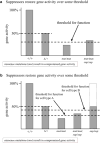From phenologs to silent suppressors: Identifying potential therapeutic targets for human disease
- PMID: 28834577
- PMCID: PMC5690827
- DOI: 10.1002/mrd.22880
From phenologs to silent suppressors: Identifying potential therapeutic targets for human disease
Abstract
Orthologous phenotypes, or phenologs, are seemingly unrelated phenotypes generated by mutations in a conserved set of genes. Phenologs have been widely observed and accepted by those who study model organisms, and allow one to study a set of genes in a model organism to learn more about the function of those genes in other organisms, including humans. At the cellular and molecular level, these conserved genes likely function in a very similar mode, but are doing so in different tissues or cell types and can result in different phenotypic effects. For example, the RAS-RAF-MEK-MAPK pathway in animals is a highly conserved signaling pathway that animals adopted for numerous biological processes, such as vulval induction in Caenorhabditis elegans and cell proliferation in mammalian cells; but this same gene set has been co-opted to function in a variety of cellular contexts. In this review, I give a few examples of how suppressor screens in model organisms (with a emphasis on C. elegans) can identify new genes that function in a conserved pathway in many other organisms. I also demonstrate how the identification of such genes can lead to important insights into mammalian biology. From such screens, an occasional silent suppressor that does not cause a phenotype on its own is found; such suppressors thus make for good candidates as therapeutic targets.
Keywords: rare disease; resiliency; suppression screen.
© Published 2017. This article is a U.S. Government work and is in the public domain in the USA.
Figures





Similar articles
-
The Caenorhabditis elegans gene mek-2 is required for vulval induction and encodes a protein similar to the protein kinase MEK.Genes Dev. 1995 Mar 15;9(6):756-68. doi: 10.1101/gad.9.6.756. Genes Dev. 1995. PMID: 7729691
-
MEK-2, a Caenorhabditis elegans MAP kinase kinase, functions in Ras-mediated vulval induction and other developmental events.Genes Dev. 1995 Mar 15;9(6):742-55. doi: 10.1101/gad.9.6.742. Genes Dev. 1995. PMID: 7729690
-
sur-2, a novel gene, functions late in the let-60 ras-mediated signaling pathway during Caenorhabditis elegans vulval induction.Genes Dev. 1995 Sep 15;9(18):2251-65. doi: 10.1101/gad.9.18.2251. Genes Dev. 1995. PMID: 7557379
-
Genetic kidney diseases: Caenorhabditis elegans as model system.Cell Tissue Res. 2017 Jul;369(1):105-118. doi: 10.1007/s00441-017-2622-z. Epub 2017 May 8. Cell Tissue Res. 2017. PMID: 28484847 Review.
-
What Can We Learn About Human Disease from the Nematode C. elegans?Methods Mol Biol. 2018;1706:53-75. doi: 10.1007/978-1-4939-7471-9_4. Methods Mol Biol. 2018. PMID: 29423793 Free PMC article. Review.
Cited by
-
Caenorhabditis elegans for rare disease modeling and drug discovery: strategies and strengths.Dis Model Mech. 2021 Aug 1;14(8):dmm049010. doi: 10.1242/dmm.049010. Epub 2021 Aug 9. Dis Model Mech. 2021. PMID: 34370008 Free PMC article. Review.
-
Humanized yeast to model human biology, disease and evolution.Dis Model Mech. 2022 Jun 1;15(6):dmm049309. doi: 10.1242/dmm.049309. Epub 2022 Jun 6. Dis Model Mech. 2022. PMID: 35661208 Free PMC article. Review.
-
In vivo quantitative high-throughput screening for drug discovery and comparative toxicology.Dis Model Mech. 2023 Mar 1;16(3):dmm049863. doi: 10.1242/dmm.049863. Epub 2023 Mar 20. Dis Model Mech. 2023. PMID: 36786055 Free PMC article.
-
WormBase 2024: status and transitioning to Alliance infrastructure.Genetics. 2024 May 7;227(1):iyae050. doi: 10.1093/genetics/iyae050. Genetics. 2024. PMID: 38573366 Free PMC article.
-
Phenotypic screening models for rapid diagnosis of genetic variants and discovery of personalized therapeutics.Mol Aspects Med. 2023 Jun;91:101153. doi: 10.1016/j.mam.2022.101153. Epub 2022 Nov 18. Mol Aspects Med. 2023. PMID: 36411139 Free PMC article. Review.
References
-
- Almoguera C, Shibata D, Forrester K, Martin J, Arnheim N, Perucho M. Most human carcinomas of the exocrine pancreas contain mutant c-K-ras genes. Cell. 1988;53(4):549–554. - PubMed
-
- Altmann HM, Tester DJ, Will ML, Middha S, Evans JM, Eckloff BW, Ackerman MJ. Homozygous/Compound Heterozygous Triadin Mutations Associated With Autosomal-Recessive Long-QT Syndrome and Pediatric Sudden Cardiac Arrest: Elucidation of the Triadin Knockout Syndrome. Circulation. 2015;131(23):2051–2060. - PubMed
-
- Barr MM, Sternberg PW. A polycystic kidney-disease gene homologue required for male mating behaviour in C. elegans. Nature. 1999;401(6751):386–389. - PubMed
-
- Beitel GJ, Clark SG, Horvitz HR. Caenorhabditis elegans ras gene let-60 acts as a switch in the pathway of vulval induction. Nature. 1990;348(6301):503–509. - PubMed
Publication types
MeSH terms
Grants and funding
LinkOut - more resources
Full Text Sources
Other Literature Sources
Research Materials
Miscellaneous

